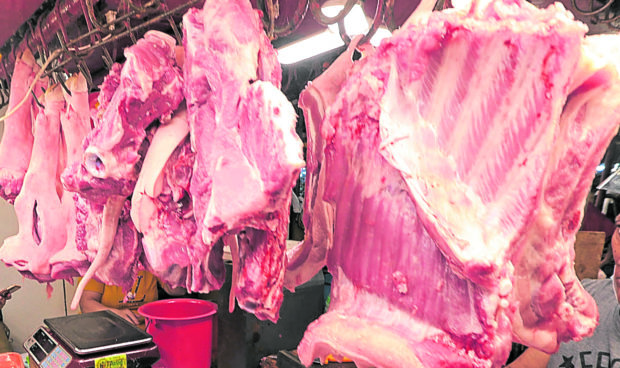MANILA, Philippines—Due to delays in pork importation, supply would remain short by 278,600 metric tons (MT) by yearend and would keep prices elevated, the state planning agency National Economic and Development Authority (Neda) said.
In a report on Monday (Oct. 25), Neda also flagged the projected shortage in supply of lowland vegetables, whose production of 1.3 million MT this year would account for 80 percent of local demand.
“Pork supply is still expected to end the year in deficit,” said Neda. This was despite the arrival of imports allowed by Executive Order Nos. 133 and 134.
As of Sept. 27, the Neda said, only 26.4 percent of the first tranche of import allotment under minimum access volume (MAV) has been used. The delay was attributable to international port closures and market restrictions.
The Neda said to speed up the use of MAV, it was recommending reduction of restrictions in MAV “so that imported pork can be sold in more areas.”
“Neda also recommends unloading more pork stocks in cold storages to the markets,” the agency said. It said the average stock of frozen pork in the first three weeks of September rose to 79,042 metric tons from 73,159 metric tons in August. “The timely release of pork stocks will help address the supply gap and bring down prices,” it said.
Socioeconomic Planning Secretary Karl Kendrick Chua, also Neda chief, said last month that imported pork, which was given a green light to meet demand amid tight supply, needed to be distributed nationwide.
“Most pork supply is in NCR [the National Capital Region], so we propose moving to outside NCR and sell in wet markets. Most imported pork is also sold in supermarkets,” Chua told the Inquirer.
Last week, Finance Undersecretary Gil Beltran, also chief economist of the Department of Finance, said pork prices could have dropped much faster if not for the three-month delay in release of imports, which had kept supply thin.
“The supply-enhancing measures through tariff reduction under EO 128 dampened food price inflation,” Beltran said.
“The contribution of meat inflation to CPI dropped from 1.09 percent in August to 1.03 percent in September,” Beltran said, referring to the consumer price index basket of goods monitored by the government.
Beltran noted that meat inflation eased to a still-high 15.6 percent in September from 16.4 percent in August as some imports augmented pork supply badly hit by the African swine fever (ASF) outbreak since late 2020.
But Beltran said “the food price reduction would have been larger if not for the continued large pork supply deficit estimated at 651,000 metric tons (MT),” citing estimates of economists Fermin Adriano and Ramon Clarete.
“This resulted from the delay in the implementation of pork tariff reduction. EO 128 was signed in April but import applications started only in July,” he added.
Neda nonetheless said that other food items would have more than sufficient supply by yearend—rice would end 2021 with a surplus of 4 million MT; chicken, 52,900 MT and fish, 117,400 MT.
“With the upcoming closed fishing season, the government will augment fish supply through the temporary importation of 60,000 MT of fish under the CNI,” Neda said, referring to the recently approved certificate of necessity to import.
Neda also expects lowland highland vegetable production to hit 717,500 MT or 70-percent more than the projected domestic demand for this year.
